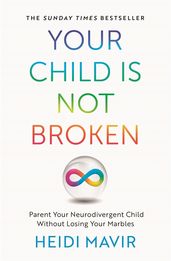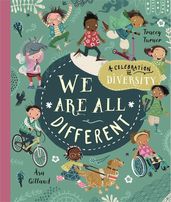Five tips for talking to children about neurodivergence
Public speaker, author, podcaster and parent to an Autistic/ADHD teenager, Heidi Mavir, who is neurodivergent herself, offers advice on how to explain neurodiversity to children.

Heidi Mavir, author of Your Child is Not Broken, offers her top tips to parents of both neurodivergent and neurotypical children on how to discuss neurodivergence in a helpful and positive way.
I was over forty-five and my son was fifteen when we discovered that we were part of the twenty percent of the population who are 'neurodivergent'.1 My son crashed out of school in what we later discovered was Autistic burnout when he was fourteen. What followed was three years of us trying to unpick what had happened, what that meant for us and how to do things differently to make sure it didn’t happen again.
I’ve often felt it would have been handy to have a cheat sheet to help me navigate conversations with my child and other people about neurodivergence, especially in those early days when I was drowning in the sea of 'information' I found on the internet (not all of it helpful). The fact is that, as parents, we are often not equipped with the knowledge needed to have meaningful, inclusive and positive conversations with our children. Every classroom will have a colourful mix of neurotypical students sitting at desks alongside Autistic, ADHD, Dyspraxic, Dyslexic and otherwise neurodivergent kids. Your children may have questions. You may not have the answers. You may feel unprepared for these conversations.
‘When we make space for children to see each other as valued individuals with diverse experiences, we lay the foundations for a more inclusive world where more, and more interesting, conversations can happen.’
It’s worth saying, that I don’t pretend to speak for all neurodivergent folks. Every person is different, family setups vary greatly from one home to another, and – as is frequently said in our community – “when you’ve met one Autistic person, you’ve met one Autistic person,” but I hope the following tips will help parents to navigate conversations with their children and young people, regardless of their neurotype.
So, here we go. My top tips for managing conversations with your children about neurodivergence.
Get to grips with the basics
By definition, a neurodivergence is 'a differing in mental or neurological function from what is considered typical.'2 Neurodivergence is a rather broad umbrella term that includes hundreds of conditions and neurotypes. The most common forms of neurodivergence are Autism, or Autism Spectrum Conditions; ADHD: Attention Deficit Hyperactivity Disorder, or ADD: Attention Deficit Disorder; Dyscalculia; Dyslexia and Dyspraxia or Developmental Coordination Disorder (DCD). Conditions such as Tourettes Syndrome, tic disorders, some mental health conditions and acquired brain injuries also fall under the banner of neurodivergence.
Challenge stereotypes
One of the biggest challenges for neurodivergent people is that a lack of education about all the different ways in which neurodivergence occurs and presents, means that our identities are steeped in stereotypes. When speaking with children and young people, I have found that it’s useful to take the approach of everyone is different and all brains work differently, rather than being caught up in sweeping statements about certain neurotypes like Autistic people lack empathy or neurotypical people love small talk.
‘Encourage children to appreciate that other people may not experience the world in the same way they do. This will foster curiosity, rather than embed alienation, and is a useful approach for all children. ’
Encourage children to appreciate that other people may not experience the world in the same way they do. This will foster curiosity, rather than embed alienation, and is a useful approach for all children.
Try the mobile phone analogy
I compare brains to mobile phones. Everyone uses their phone differently: some of us have hundreds of apps downloaded and multiple tabs open, whilst others use their phone only for texting and making the occasional call. Like phones, everyone’s brains are different in how we use them and what we use them for. Not only do we use our phones in different ways, but we also use phones that have different operating systems: I think of iPhones as neurotypical brains and Androids as neurodivergent brains. Neither is better (contrary to what some might say) and they share lots of similarities. They are, though, fundamentally different – an Android phone isn’t 'a little bit iPhone' just like a neurotypical person is not 'a little bit Autistic.'
Help them understand sensory differences
It can be helpful for our children to know and understand their sensory profile. For neurotypical kids, this can help foster empathy for their neurodivergent classmates: knowing how it 'feels' when your sensory system is triggered by an unpleasant stimulus (for example, the experience of an accidental nettle sting) can help you begin to understand how your neurodivergent friend might experience the seams in socks and label in their school shirt. Equally, our neurodivergent kids need to know that they may not feel thirsty in the same way as their neurotypical peers and might need to take cues from classmates to ensure they stay hydrated during the day. One of my hacks has always been to drink water when I see someone else doing it because I rarely feel thirsty.
Make generous assumptions
As a neurodivergent person, some of my most painful experiences have been around people making assumptions that I am choosing to be the way that I am. People are terrified to use the word disabled, but the fact remains that neurodivergence is a disability that impacts every part of my life. I don't consider 'disability' a dirty word: it’s a description which tells people that I need understanding and accommodations. The need for generous assumptions is especially true for neurodivergent learners in a school environment. When your brain is on fire and your sensory system is triggered, it’s hard to focus and almost impossible to engage in learning.
‘As the parent of a neurodivergent child, you will need to remind other people and your child that kids do well when they can do well. Meanwhile, as the parent of a neurotypical child, remembering that your child’s neurodivergent peers will need patience, understanding and kindness, especially at times when everyone is feeling frazzled and misunderstood, will serve them well. ’
As the parent of a neurodivergent child, you will need to remind other people and your child that kids do well when they can do well. Meanwhile, as the parent of a neurotypical child, remembering that your child’s neurodivergent peers will need patience, understanding and kindness, especially at times when everyone is feeling frazzled and misunderstood, will serve them well.
I hope you find these useful. Please know that you don’t have to have all the answers. These conversations make space for our kids to become more accepting of themselves, ask questions, embrace their neurotypes and feel confident in developing their skills of self-advocacy. When we make space for children to see each other as valued individuals with diverse experiences, we lay the foundations for a more inclusive world where more, and more interesting, conversations can happen.
Your Child is Not Broken
by Heidi Mavir
An unapologetic and deeply moving manual for parents of neurodivergent children from Heidi Mavir, a late-identified, neurodivergent adult and parent to an autistic/ADHD teenager. Follow Heidi's irreverent and brutally honest story of her fight to be seen, heard and supported, while swimming against a tide of parent blame, ableist stereotypes and the weight of other people’s opinions. Your Child Is Not Broken is a call to arms for parents and carers of autistic, ADHD, or otherwise neurodivergent children. It is the book that no one has dared to write but every parent needs to read; it is permission to do things differently.
You may also be interested in these books for children and young adults
You can also find children's book recommendations by age group: take a look at the 50 best books for 5-year-olds, great books for seven-year-olds, brilliant books for seven year olds, perfect reads for nine- to twelve-year-olds and our guide to the 50 best YA books to read right now.
We Are All Different
by Tracey Turner
This vibrant, inclusive book, created in conjunction with several Inclusive Minds Inclusion Ambassadors, introduces us to a cast of children who have different abilities and disabilities, likes and dislikes; who come from different places and have different cultures and ethnicities; and who have different family structures. It reinforces that everyone has something to offer, that diversity enriches our lives, and it also considers what all human beings have in common – that there is more that unites us than divides us.
Discover the best parenting books for invaluable advice on communicating with your children.
1 Neurodiversity at work: a biopsychosocial model and the impact on working adults
2 OED definition




